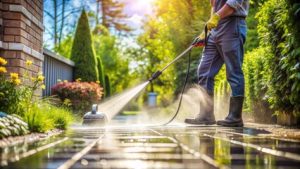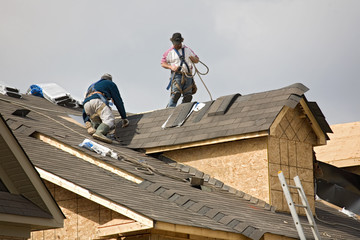A roof’s lifespan depends on many factors including the type of roofing material and quality of maintenance. However, as a roof ages it becomes more prone to damage and leaks.

Repairing or replacing a damaged roof can save homeowners money over time. However, some repairs require extensive work. It is important to understand a roof’s warranty and its coverage.
The shingles of your roof provide the first line of defense against water intrusion. As such, they should be carefully inspected and regularly repaired to ensure long-term integrity.
Cracked shingles are one of the most common signs that your roof is in need of repair. This may be due to weather fluctuations, heavy impact, or simply aging of the shingle itself. If left unrepaired, cracked shingles can cause leaks and other problems throughout the home.
In addition to examining your shingles for damage, look for the presence of algae and/or moss growth. This often indicates excessive moisture and poor ventilation in the attic. If left unrepaired, these issues can lead to shingle decay and eventual dislodgement.
While you’re up on your roof, take a close look at the flashing around your chimney. This thin, metal sheeting directs water away from the chimney and is vital to prevent water from seeping into your home’s structure. For a quick and temporary repair, apply roof tar to the top of any leaking or torn areas of your shingles. This will help seal the area until you can address the problem more fully.
If you suspect wind-damaged shingles, have an expert conduct a thorough inspection. In some cases, wind-damaged shingles can compromise the entire integrity of your roof and leave your home vulnerable to leaks and other damage. Additionally, a professional will be able to determine if your roof is eligible for homeowners insurance coverage and the specifics of your deductible.
If you decide to undertake the repair yourself, make sure that you have the necessary materials and tools before starting. This includes a ladder, safety harness, and gloves. You’ll also need roofing nails, a flat pry bar, and roofing cement. Additionally, it is important to work in cool weather, as working in extreme heat can be dangerous and compromise the effectiveness of your repairs.
Leaks
Few things will ruin your home’s cozy atmosphere like a leaky roof. The drip-drip-drip of water can leave mold, mildew and stains on ceilings and walls and may cause additional structural damage to your roof or foundation. The good news is that leaks are often easy to repair — and they can be prevented by regular maintenance and preventative measures.
Leaks usually enter a home through worn or broken shingles, loose nails or corroded or poorly installed flashing around vent pipes, chimneys and skylights. Once inside the roof structure, a leak can ebb along sheathing, rafters or the topside of ceilings until it finds a place to pool and drip.
A leaking roof can be caused by many different factors, including old age or a severe storm. The most important thing is to stop the flow of water and minimize any additional damage. If you are unsure how to fix the problem or want to ensure that you’ve taken all precautions to protect your property and safety, contact a professional roofer for assistance.
While you wait for professionals to arrive, it’s a good idea to make a temporary repair to any areas where the water has already made its way into your living space. You can use a piece of tar paper or plastic sheeting to cover holes or tears. If the area is still dripping after the patch, you should inspect the roof for more extensive damage or leaks.
You can also check the attic for moisture or signs of a leak by using a garden hose to flood the roof. Start at the eaves and work your way down, taking care not to step on insulation or the ceiling below. If you see moisture or a leak, mark the spot on the attic ceiling with a nail to help locate it for rooftop repair.
Finally, you should regularly inspect the roof and gutters to ensure they are free of debris. Clogged gutters can overflow and back up under shingles, creating a dam that can trap water and cause leaks. It’s a good idea to clean out your gutters after every significant storm or on a monthly basis.
Damaged Flashing
Roof flashing is a crucial component of any roof, protecting vital areas such as chimneys, vents, and intersections where the roof meets vertical structures. However, like other roofing materials, flashing is vulnerable to damage from weather and age and may require repairs or replacement. When flashing deteriorates, it can allow water to seep into the home, leading to ceiling stains, mold, and structural issues. Understanding the signs of flashing problems allows homeowners to take action before they become more serious, preventing costly water damage repairs and potentially even enabling insurance coverage for the damaged area.
The most common sign of failing flashing is visible rust or corrosion around the edges, or cracks or gaps where flashing should be tightly sealed against surfaces. Other indicators include water stains on the ceiling or walls, especially following heavy rains or other precipitation. Cracking or separating from the roof also indicates flashing is in need of repair, as is a shift in the position of the flashing from its original place.
Flashing can be repaired by a professional roofing contractor with the right tools and knowledge. During this process, the damaged section of flashing is carefully removed without damaging the surrounding roofing materials and is replaced with new flashing, cut to precise measurements and firmly sealed and covered with high-quality roofing cement. The seams are then covered with shingles for a finished look and to help prevent moisture penetration.
In addition to repairing flashing, a professional roofing contractor can install new skylights, replace chimney caps, and install gutters and downspouts. It is also recommended to perform regular roof inspections and have severe weather-related damages addressed immediately, in order to avoid leaks and other complications. To learn more about how to spot flashing damage and how to protect your home from water intrusion, contact a trusted local roofing contractor for a consultation. This is the best way to keep your home safe and dry for years to come.
Gutters
Gutters are a crucial part of the roof system. They catch water runoff, channel it away from the house and prevent moisture from damaging wood fascia and soffits (the underside of the roof overhang) as well as the home’s foundation. Problems with gutters can include overflow, sagging, leaks and clogs.
Often, the only way to find out what’s wrong with your gutters is to climb up on the ladder and check for yourself. Start by cleaning the gutters of debris. Then, use a water hose to spray down the gutters to make sure they’re flowing correctly. If they’re not, you might have a low gutter pitch that causes water to flow over the sides of the gutter instead of down the downspouts. This can also cause downspouts to pull loose from the gutters.
Leaking or loose gutters can pull loose from the fascia board, which can lead to rot and water damage. Look for rust and corrosion on gutter spikes and ferrules, the large bolts that hold the gutter to the fascia board. If they’re loose, tighten them using a drill with a hex bit. Also, check for rusted or loose gutter hangers, which can pull out of the gutter and cause sagging. If the hangers are loose, renail them to the fascia board with galvanized roofing nails and seal the nail holes with roof cement.
Overflowing gutters can cause water to pool up against the fascia and soffit, which can rot or leak through the underside of the roof overhang. This can cause mold, mildew and wood rot that can cause extensive attic and home damage. In addition, standing water can erode the soil under the foundation, causing it to settle and crack.
Overflowing or leaking gutters are common problems that can occur with any type of roof, but especially those with shingle systems that have poor pitch, valleys, seams and downspout connections. Regular maintenance and cleaning can keep these problems from happening, but if you do encounter them, the following steps can help you repair the problem quickly.

